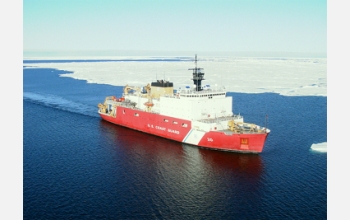Media Advisory 06-013
NSF Invites Reporters to Apply for Berth on Bering Sea Research Cruise

Journalists may spend five days aboard the icebreaker Healy during a research mission.
April 3, 2006
This material is available primarily for archival purposes. Telephone numbers or other contact information may be out of date; please see current contact information at media contacts.
The National Science Foundation (NSF), through its Office of Legislative and Public Affairs, is accepting written requests from professional journalists to join an ecosystem and environmental research cruise in Alaska waters that is studying changes in the northern Bering Sea. The cruise is part of the St. Lawrence Island Polynya project, which looks at biological responses and ecosystem changes on the Bering Sea shelf region caused by increased average air and water temperatures.
Application Deadline: April 17, 2006Previous studies conducted in the region indicate profound changes are taking place in communities of bottom-dwelling animals as a result of a decline in organic carbon supplies. Such changes are affecting the food supply of species such as sea ducks and marine mammals, forcing those populations northward.
A study of the changes was recently published in Science magazine and was the topic of an NSF news release: http://www.nsf.gov/news/news_summ.jsp?cntn_id=106750
Research cruises scheduled for May 2006 and 2007 will continue studies of this ecosystem change, including field collection to investigate the potential migration of bottom-feeding fish and predators such as crabs and snails into this productive region. Scientists will deploy water- and sediment-sampling devices for animal sample collections and observing seawater temperature and sea-ice concentration and extent. Observations of diving sea ducks, walrus and ice seals will also be carried out. Journalists selected will go to sea for five days aboard the U.S. Coast Guard icebreaker Healy during the last week of May.
U.S. media receive preference in selection.
Application: Applicants must submit a reporting plan of no more than two typed pages in length explaining specifically why they wish to cover this cruise and who the audience for their stories will be. A selection committee of Arctic program science and logistics personnel and media officers from NSF's Office of Legislative and Public Affairs (OLPA) will review all proposals and select the finalists. The committee looks for proposals that indicate an understanding of the nature and challenges of NSF's scientific enterprise in the Arctic and the desire to communicate that understanding to the public. Proposals from print, television, and radio journalists, as well as from on-line news operations, are welcome. U.S. mass media that serve primarily language-minority audiences are also encouraged to apply.
Costs: Reporters or their employers pay for round-trip transportation to--and accommodations in--Nome, Alaska as well as a one-hour flight in and out of Gambell, Alaska on St. Lawrence Island to meet the ship's helicopter for the flight to and from the ship. NSF furnishes cold-weather clothing solely for use in the field, as well as housing, transportation and food while on the cruise, at no cost to the reporters.
How To Apply: Contact NSF (by phone or by e-mail) as soon as possible to express interest and to obtain background materials. Freelancers must supply evidence of a firm commitment to publish or air their work on their prospective employer's letterhead.
Send the letter and any supporting materials (such as a limited number of clips or videotaped segments) to:
National Science Foundation
Office of Legislative and Public Affairs
4201 Wilson Boulevard, Suite 1245
Arlington, VA 22230
Attn: Peter West
-NSF-
Media Contacts
Peter West, NSF, (703) 292-7761, email: pwest@nsf.gov
The U.S. National Science Foundation propels the nation forward by advancing fundamental research in all fields of science and engineering. NSF supports research and people by providing facilities, instruments and funding to support their ingenuity and sustain the U.S. as a global leader in research and innovation. With a fiscal year 2023 budget of $9.5 billion, NSF funds reach all 50 states through grants to nearly 2,000 colleges, universities and institutions. Each year, NSF receives more than 40,000 competitive proposals and makes about 11,000 new awards. Those awards include support for cooperative research with industry, Arctic and Antarctic research and operations, and U.S. participation in international scientific efforts.
Connect with us online
NSF website: nsf.gov
NSF News: nsf.gov/news
For News Media: nsf.gov/news/newsroom
Statistics: nsf.gov/statistics/
Awards database: nsf.gov/awardsearch/
Follow us on social
Twitter: twitter.com/NSF
Facebook: facebook.com/US.NSF
Instagram: instagram.com/nsfgov


